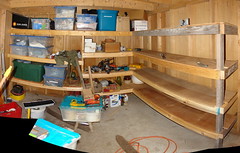Considering the huge number of specific guides about building storage shed shelves I decided not to add another one (at least until I make the shelves for my own shed). Instead of this, here is a really quick and easy guide showing you how to build three different types of shelves. I have linked to pages with more information where appropriate.
The full resource list is at the bottom, along with several sites offering plans. All the links are carefully selected so hopefully you'll find them very useful.
Build Wooden Shelves - Steps:
Wooden shelves fixed to the wall are the most popular solutions for do-it-yourself fans. Stable and good!
- mark the position of the slevles on the wall
- attach rear beams to the wall if needed
- cut out the shelf size
- nail pieces underneath to the front, back and sides
- fix the shelf back to the shed wall
- or use diagonal braces
Build Iron Shelves - Steps:
Iron shelves are very stable and affordable. If you are installing them in a humid shed you will need rust treatment.
- mark the position of the slevles on the wall
- buy modular angle iron
- use scrap MDF, OSB or lumber for the shelves
- bolt the angle iron to the shed walls like explained here
- use mild steel - it's cheaper
Build Free Standing Shelves - Steps:
Standing shelves can be moved and are good solution if you often rearrange your storage space or move your home. They are less stable than the fixed-to-wall shelves and shouldn't be overloaded with stuff.
- cut shelve and support pieces
- make shelf frames
- attach plywood to the frames with screws
- add an 8-foot 2-by-4 to each corner of the shelves.
- have 2, 3 or 4 shelves per unit
Random Tips:
- Use left over lumber or scrap timber. Shed shelves don't need to look great, they need to be functional.
- Or buy a plastic shelf kit. They are affordable and save time.
- Build or use freestanding shelves. While they are not as stable, they can be easily moved to clean, repair, or rearrange your shed.
- Use plastic boxes to store items on the shelves. Categorize and label the boxes. This way you'll store more stuff and will be able to find it quickly when you need it.
- If you are building shelves in a garage make sure there is enough space for the car.
- You'll need a saw, drill, level, measuring tape, pencil.
- Start with design on paper or computer. Use software like Google Sketchup to visualize your shelves.
- Based on the design calculate the materials. Make sure you have some reserve in case you make mistakes when cutting.
- You can also build the shelves from pieces of wood (boards).
- For better stability build ladder supports. See the second picture here.
- OSB shelves will sag under heavy weight. Good plywood, timer boards or metal are better options.
What I gave you so far should be enough to get you started with the drawing phase, choosing the materials and getting ready. Below are some specific shelve plans and a list of the guides I used as resources. Pick the ones you like or just draw your own plans and start:
Some Shelve Plans:
- Plans for easy shelf unit that can be built of stock lumber.
- A collection of plans for non-standard shelves and other stuff.
- Cheap, easy, low-waste bookshelf plans that you can of course use to store other stuff too.
And Here Are The Resources (Specific Guides):
- Storage Shed Shelves - a couple of illustrations showing very well how you can build storage shed shelves
- A Quick Guide On How To Build Shelving In Your Shed
- Project Shed: Shelving - You need plenty. - building metal storage shelves. By the way this is great idea epsecially if you have a metal storage shed.
- Cheap, Easy-to-Build Wood Storage Shelves
- How to make garden shed corner shelves
- Good guide on materials
- How to build garage and basement shelves - this guide shows building with pieces of wood
- How to Build Inexpensive Basement Storage Shelves
That's it! Do you know of any other shelf types that are good for building yourself for your shed?



